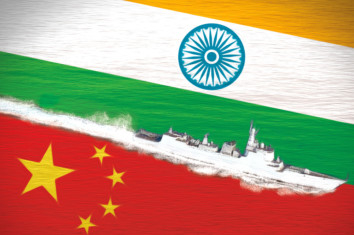
Right now China and India are glaring at each other across Doklam, the contested ground along the Sino-Indian frontier high in the Himalayas. It was the Himalayan border that had prompted their last serious fight, when China’s People’s Liberation Army (PLA) dealt the Indians a short, sharp defeat in 1962. But any future war may not be fought on the high mountains, but the high seas.
A Sino-Indian naval war seems improbable, for sure — but so do most wars, before they happen. It’s certainly not unthinkable, and so it behoves Asia-watchers to lay out the odds now rather than be guilty of a failure of imagination should the worst transpire. Don’t be taken in by the numbers, indicating that China would steamroller India in a sea fight. Martial enterprises are seldom that neat.
China has settled its border disputes with most in the region — but it prefers to leave the contest with some of its neighbours simmering, especially India. A spokesman for China’s defence ministry, Col Wu Qian, warned Indians not to “push your luck” in the Doklam dispute. For good measure Wu added that the Indian Army would find it “easier to shake a mountain than to shake the PLA”. History shows that rancour on land or in the air can easily sprawl out to sea. Or a saltwater conflict could ensue independently of events ashore. Both contestants take a proprietary view of waters off their coasts. China thinks about the South China Sea as a zone of “indisputable” or “irrefutable” sovereignty where Beijing ought to make the rules and others ought to obey. In a similar vein, India models its foreign policy and strategy in part on the Monroe Doctrine, and thus regards the Indian Ocean as an Indian preserve.
Such claims should have a familiar ring to Americans. During its own rise to regional and world power, the United States sought to exclude powerful outsiders from the Caribbean Sea and Gulf of Mexico — its outlet to the Pacific Ocean. The Monroe Doctrine started off as a joint defence of the Americas against European imperial powers. It ended up with Washington proclaiming its “fiat [was] law” throughout these waters, and that it could exercise an “international police power” there — meddling in fellow American states’ affairs to preclude European seizures of territory in the Western Hemisphere.
Chinese courtship of South Asian coastal states looks suspiciously like an effort to construct a “string of pearls”, or network of naval bases in the Indian Navy’s traditional operating grounds. Most recently, Beijing negotiated a 99-year lease of the Sri Lankan seaport of Hambantota, lodging itself firmly in the sub-continent’s environs, while Chinese engineers have fortified their naval station in Djibouti, in the extreme western reaches of the Indian Ocean.
In short, the kindling for marine conflict is increasingly in place while any number of quarrels between New Delhi and Beijing could strike the match.
So, who would come out on top in an armed conflict?
Well, the two navies are roughly comparable in aircraft-carrier aviation, operating one modest flat-top apiece. That parity in numbers appears set to persist for some years, but aircraft-carriers aren’t the whole of naval striking power. On paper, the Indian Navy looks massively outgunned across the board. Consider: In 2020, the PLA Navy will have 73 attack submarines, or “attack boats” in US. Navy slang, in its inventory. Attack boats are subs built to hunt other subs or pummel surface fleets from the depths. The Indian navy will operate 17 such craft in 2020. That looks like a 4:1 deficit for New Delhi.
China’s navy will also field an increasingly modern mix of 30 guided-missile destroyers (DDGs) by 2020. DDGs act as a carrier’s “shotgun”, using their missiles to fend off aerial, missile or subsurface assault. They can also serve as capital ships in their own right, leading surface action groups against other fleets or shore targets. By comparison, the Indian Navy will have a paltry eight DDGs. The PLA Navy will have a mix of 92 frigates and corvettes, light combatants for duty in less menacing settings. The Indian Navy will have 32 frigates and corvettes.
And so forth.
These are overpowering numbers. They imply India will play Bambi to China’s Godzilla in any maritime conflagration — and we all know what happens when Bambi meets Godzilla. Even Admiral Horatio Lord Nelson, Britain’s virtuoso of sea battle in the age of sail, insisted that “only numbers can annihilate”.
But numbers seldom if ever tell the whole story in marine combat.
Consider several factors that will blunt what looks on paper like an insuperable edge. First, think about the human factor. A force inferior in numbers can outfight a larger antagonist through superior seamanship and tactical dexterity. It might escape annihilation. It might even defeat that antagonist’s aims. The weak can win — and often have in the annals of warfare. My own guesswork: Both navies would acquit themselves about equally well in action. Finally, bear in mind that naval warfare is no longer about navies alone. China’s military boasts an array of land-based weaponry to make things hard on American or Asian forces steaming within reach of that weaponry. But Indian commanders can tap that same logic when fighting within reach of their own shore-based arsenal of tactical aircraft and missiles.
So, who would prevail in the Sino-Indian naval war of 2020? It looks like a close-run thing. China has numbers on its side, but India’s allies include geography, land-based sea power, and silent partners such as the US and Japan.
— Washington Post
James Holmes is a professor of strategy at the Naval War College, a combat veteran of the Gulf War, and co-author of Red Star Over the Pacific: China’s Rise and the Challenge to US Maritime Strategy.










